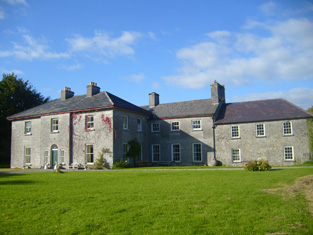Garryduff
Houses within 10km of this house
Displaying 14 houses.
Houses within 10km of Garryduff
Displaying 14 houses.
| House name | Description | |
|---|---|---|
| Glenastar Cottage | Occupied by William Osward circa 1840 and described as a large house of 2 storeys. Held by William R. Yeilding in fee at the beginning of the 1850s and valued at £7.5 shillings. The residence of Richard M. Yielding in 1814. |

|
| Glenville | The Massys lived at Glenville from the 1760s. The present house was built by William Massy in 1808. William Massey was resident in 1814, J. Massey in 1837 and William Massy in the early 1850s. William Massy held the house valued at almost £14 from Stephen Creagh. The house came into the possession of the Langford family, relations of the Massys in the early 20th century and they were still resident there in the 1970s. |

|
| Dromin | This house was the home of Nicholas Meade in 1837 and of his representatives in the early 1850s. It was located on the Devon estate and was valued at £13. It is still extant and occupied. |

|
| Moyveedy | A house on the Devon estate valued at £10 and occupied by Thomas Fitzgerald in the early 1850s. The house is still extant and part of a large farm. |

|
| Cloonyscrehane | This house, located on the Devon estate, was valued at £12 at the time of Griffith's Valuation and was the residence of Patrick Candon. A house and farm are still extant at the site. | |
| Cullenagh | This house, situated on the outskirts of Newcastle West, was the home of Patrick Griffin in 1814 and at the time of Griffith's Valuation. Valued at £27 it was held from the trustees of the Earl of Devon. The house remained until the mid 20th century but is no longer extant and a large industrial complex exists to the rear of the site. | |
| Woodlawn | A house on the Devon estate occupied by George Bolster, medical doctor, at the time of Griffith's Valuation and valued at £11+. Woodlawn was the residence of R. Cart in 1837. It is still extant. | |
| Lissurland | This was an O'Brien home located on the Devon estate. Occupied by Connor O'Brien in 1814 and Henry O'Brien in the early 1850s, when the buildings were valued at £12. The house survived into the 20th century but is no longe extant. | |
| Newcastle | The original Fitzgerald castle was granted to the Courtenay family in 1591. The Castle was occupied by David Mahony and his son, Pierce Mahony, in the mid 18th century. Bence Jones writes that the residence of the Earls of Devon in county Limerick was a house of nine bays in the castle precincts. It was held by them in fee and valued at £55 at the time of Griffith's Valuation. This house was occupied by the agent to the Devon estate. Slater describes it as Courtenay Castle in 1894 when it was occupied by Charles Curling. In 1910 it was bought by the Curling family who had been agents and was burnt in 1922. The Castle remained in the possession of the Curlings until the 1940s. |

|
| Ballintober | A house occupied by Cornelius Curtin at the time of Griffith's Valuation and held by him with 132 acres from John C. Heffernan and partners, valued at £12. | |
| Castleview | Occupied by Brian Sheehy in 1814 and by Thomas Locke in 1837. At the time of Griffith's Valuation Castleview was the residence of the Rev Robert M. Rodwell, the buildings were valued at £30. Birthplace of William John Locke Travers in 1819, a New Zealand lawyer, politican and naturalist, see http://www.teara.govt.nz/1966/T/TraversWilliamThomasLocke/TraversWilliamThomasLocke/en | |
| Ashgrove | Ashgrove was the home of the Upton family in the 18th century. Occupied by John Upton in 1814 and J.W. Upton in 1837. This house was being used as an Auxiliary Workhouse at the time of Griffith's Valuation. William Stephenson held the townland at this time. His interest was advertised for sale in June 1854. The tenant was Mr Denis Moylan who held on a 7 year lease from May 1852. A house is still extant at this site. | |
| Glenastar | Glenster was occupied by Samuel Upton in 1814 and by J.U. Upton in 1837. Described at the time of the first Ordnance Survey as a small thatched house of one storey, the residence of John Upton. By the time of Griffith's Valuation the townland of Glenastar was held by the representatives of John Upton. The highest value on any house in the townland was £1.15 shillings and it was held by them in fee. A house is still extant at Glenastar. | |
| Ballynabearna | Occupied by William J. Upton in 1814 and by W. Upton in 1837. This house was valued at £2 in the early 1850s and held by John Upton from Sir Robert Bateson. the building labelled Ballynabearna House on the 1st edition Ordnance Survey map is not the same as the house on the later 25-inch map of the 1890s. Buildings are still extant at the site. |

